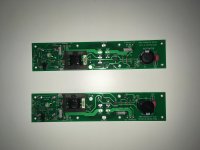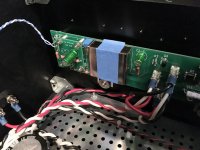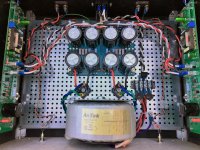Hi Claas,
Thank you also for the info. For the belly band, is that some kind of copper foil tape?
Would you have a reference/part for that?
Thanks,
Dennis
Ebay, copper foil tape | eBay
Yes, that should work well.
I used 3M type 1181 copper foil tape. Important is the conductive adhesive. Most of the tapes in the link above feature that.
Even better would be 3M type 1345, especially made for this purpose.
(sample link: https://www.ebay.com/itm/TapeCase-3...960165&hash=item54463fd62a:g:HewAAOSwIWVY88UN )
... but that felt too expensive for me 😛
Best regards,
Claas
I bought a roll of 3/4" 3M type 1345 and offered samples in the main M2 thread, but no takers. Sometimes it can be found relatively cheaply.
BK
BK
My parts for the M2X are starting to show up
I got my M2X PCB boards yesterday, and all the necessary transistors to build the amplifier main boards and the Ishikawa input stage today. I already had the Universal PSU PCB boards and a set of soft start/speaker protection boards on hand (I ordered the soft start/speaker protection boards a couples month ago to use for an Aleph J build, but this thread convinced me to try the M2X instead).
I will create an order for all of the parts to populate the amplifier and power supply boards, but can't afford to place the order until the end of the month. I will be placing an order for those Edcor autoformers then too.
As this is my first full DIY project (I have modified a few things in the past), I am taking my time, and ensuring I have everything on hand before I actually start building. This will also give me time to see what others here are choosing for their input stages, and how things are working out.
Someone mentioned having extras of those red "do not substitute" LED's on this thread. I have forgotten who that was, but if they can contact me, I will gladly buy a set at the end of the month (PM me with PayPal information).
Kendra
I got my M2X PCB boards yesterday, and all the necessary transistors to build the amplifier main boards and the Ishikawa input stage today. I already had the Universal PSU PCB boards and a set of soft start/speaker protection boards on hand (I ordered the soft start/speaker protection boards a couples month ago to use for an Aleph J build, but this thread convinced me to try the M2X instead).
I will create an order for all of the parts to populate the amplifier and power supply boards, but can't afford to place the order until the end of the month. I will be placing an order for those Edcor autoformers then too.
As this is my first full DIY project (I have modified a few things in the past), I am taking my time, and ensuring I have everything on hand before I actually start building. This will also give me time to see what others here are choosing for their input stages, and how things are working out.
Someone mentioned having extras of those red "do not substitute" LED's on this thread. I have forgotten who that was, but if they can contact me, I will gladly buy a set at the end of the month (PM me with PayPal information).
Kendra
Given previous "horror stories" regarding the PSUs, be sure to test the PSU before hooking up the amp channels!
Where can one get the cover for edcor trafo?
You can fold your own from mu-metal.
https://www.diyaudio.com/forums/pass-labs/281520-official-m2-schematic-311.html#post5569239
This reduced the noise down to 0.1mV on one channel and 0.3mV on the other.
Where do you get "cheap" mu-metal?
It may also be possible to use mu-metal tape. I know this company sell it (but expensive). But tape may be easier to "apply":
3200 to 4700 - EMI shielding tape | Holland Shielding Systems BV
May also be possible to find it on ebay.
So the problem is that the transformer act as a "pickup" and pick up som stray fields from PSU?
Think my solution will be so isolate the M2X boards from the PSU. If hum is a general problem with this amp the building guide maybe should be updated on how to avoid it in first place?
It may also be possible to use mu-metal tape. I know this company sell it (but expensive). But tape may be easier to "apply":
3200 to 4700 - EMI shielding tape | Holland Shielding Systems BV
May also be possible to find it on ebay.
So the problem is that the transformer act as a "pickup" and pick up som stray fields from PSU?
Think my solution will be so isolate the M2X boards from the PSU. If hum is a general problem with this amp the building guide maybe should be updated on how to avoid it in first place?
Given previous "horror stories" regarding the PSUs, be sure to test the PSU before hooking up the amp channels!
Thanks Rafa for the reminder. My first project was an Aleph J and I followed the instructions to a “T”. I’ve got my lightbulb tester ready to go for when I’m ready to test and start powering the boards up. Simple device, excellent quick warning for a potential poof!
Where do you get "cheap" mu-metal?
It may also be possible to use mu-metal tape. I know this company sell it (but expensive). But tape may be easier to "apply":
3200 to 4700 - EMI shielding tape | Holland Shielding Systems BV
May also be possible to find it on ebay.
So the problem is that the transformer act as a "pickup" and pick up som stray fields from PSU?
Think my solution will be so isolate the M2X boards from the PSU. If hum is a general problem with this amp the building guide maybe should be updated on how to avoid it in first place?
I don't think that there is any "cheap" Mu-Metal. I paid $122 for a 2' x 4" x 0.01" piece of Mu-Metal foil from McMaster Carr.
Before the Mu-Metal shielding, I was seeing noise levels of around the 500 uV, which is the First Watt specification for the production version. After shielding, I measure around 100 uV (0.1 mV), which is quite an improvement and the limit of my test equipment.
I'm sure there will be more feedback for builders regarding shielding techniques as more people build the M2x.
Attachments
One more thing: To reduce hum, try to separate the power transformer from the input transformer as far as possible. A deeper case than I used would be better to maximize the distance.
Attachments
Last edited:
One more thing: To reduce hum, try to separate the power transformer from the input transformer as far as possible. A deeper case than I used would be better to maximize the distance.
Nice neat build! Where did you get the mounting bracket for the toroid? Or is it a DIY homemade bracket? If so, what metal did you use?
Thanks!
Nice neat build! Where did you get the mounting bracket for the toroid? Or is it a DIY homemade bracket? If so, what metal did you use?
Thanks!
Bracket is an L-300 from Toroid Corporation. The L-300 is a good fit for the AnTek AS-3218. I have also used the L-625 L-bracket which is a good fit for the Antek AS-4218.
VERTICAL MOUNTING BRACKET FOR TOROIDAL TRANSFORMERS
Thank you, WKCox! Here are the sales pages for those mounting brackets:
Thank you, WKCox! Here are the sales pages for those mounting brackets:
Bracket is an L-300 from Toroid Corporation. The L-300 is a good fit for the AnTek AS-3218. I have also used the L-625 L-bracket which is a good fit for the Antek AS-4218.
Thanks WKCox! I’ve sent them an email for pricing.
Joe
Thank you, WKCox! Here are the sales pages for those mounting brackets:
Thanks for the links Mark! I hadn’t considered or even noticed the Omega bracket. I may consider that one instead.
Joe
I don't think that there is any "cheap" Mu-Metal. I paid $122 for a 2' x 4" x 0.01" piece of Mu-Metal foil from McMaster Carr.
Before the Mu-Metal shielding, I was seeing noise levels of around the 500 uV, which is the First Watt specification for the production version. After shielding, I measure around 100 uV (0.1 mV), which is quite an improvement and the limit of my test equipment.
I'm sure there will be more feedback for builders regarding shielding techniques as more people build the M2x.
I have become a fan of having the PSU in a separate chassis. This will be my approach when building the M2X.....or any amp.
My first foray into Pappa's world. ( as long as you don't count modifying old ADCOM mosfet amps )
A good story always starts at the begining, which in my case started with a pair of HK775's which I bought to tinker with and was curious how they sounded.
HK775
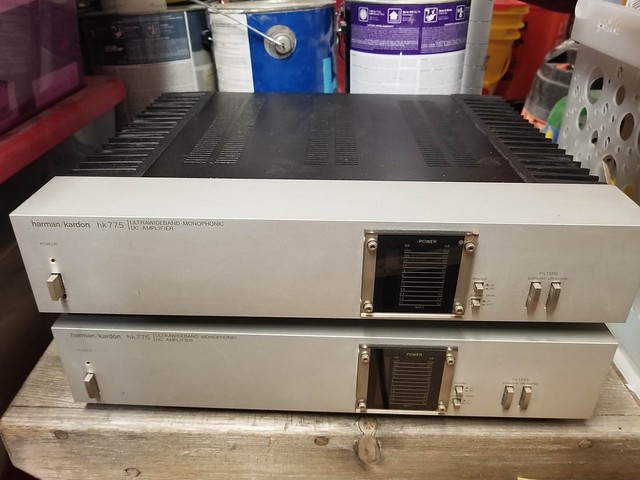
After replacing one of the push buttons and trying to clean up the amp, I ended up giving them a face lift
= much to some purists distress.
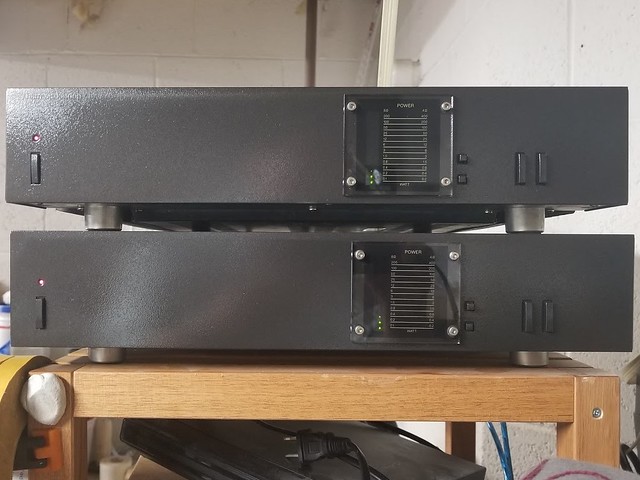
I have been lurking on the Pass forum for a very long time, most of my DIY endeavors have been headphone oriented, so little need to spend much thought aside from curiosity. Then while working late one night I happened to stumble on an add for a set of M2x boards - I had been toying with buying the First Watt M2 and just never pulled the trigger and had let the original GB pass me by as I had too many other things going on at the time, so this was a momentary lapse of reason and a little late night weakness/delirium
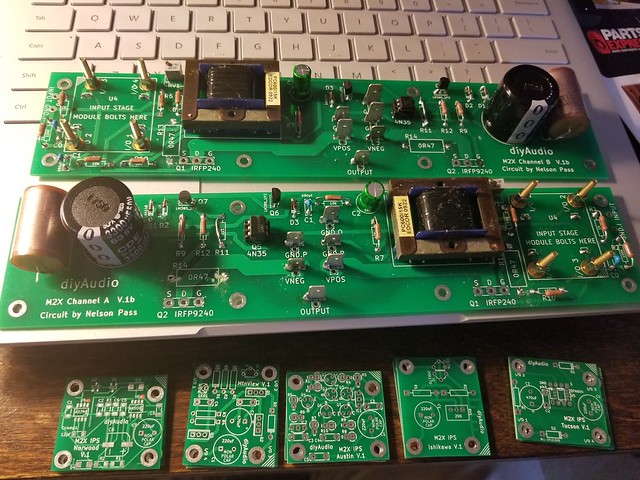
This weakness had mostly been spurred on by ZenMod's fantastical thread "Most Greedy Boy, of them all... or (there is no) DEFiSIT of Papa's Koans"
I then enquired from the person that I bought the M2X from as to what had driven him to unload this precious cargo and the next thing I knew ....
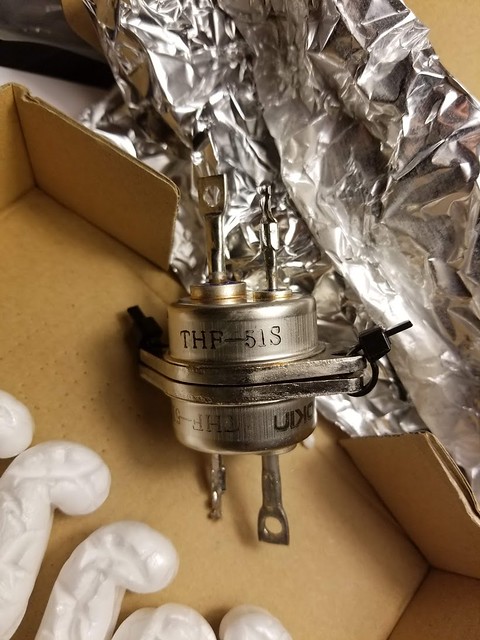
tested them to make sure they were good

but that remains for another day.
I guess I have become a little derailed in my story telling as not soon after had I refurbished the HK's and had them singing some fairly impressive tunes, one died with the release of special faerie dust never to be rescussitated . Now that I had a set of boards, I got to thinking , would they fit ? The heatsinks are thick solid blocks of aluminum so I gutted the original carcass and voila, a near perfect fit.

As the chassis is mono, I did some patching and modified it to stereo

I by this time had gradually paged through all of the M2 and M2x threads and became aware of a theme that was a little concerning - noise in the signal , most likely being picked up by the edcor transformer that the M2 uses. Hum has been a point of sore contention recently as I have spent most every free minute trying to kill an annoying hum that has plagued a tube hybrid headphone amp I had built.
I recalled that a dear friend of mine had designed a current limiter and noise cleaner for a pair of smps supplies I had.
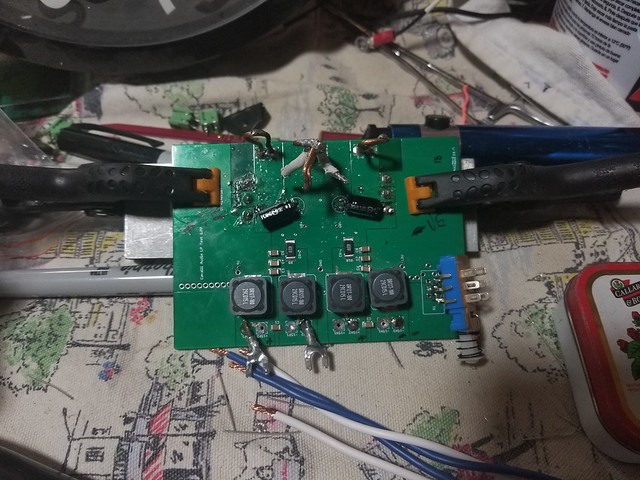
I tested it bolted to external heatsinks and it worked perfectly. I needed to reseat the mosfets under the board as the rig with the heatsinks didn't fit in the case - got it looking good with a nice tight fit and tested again - nothing, for some reason the Fets would not switch on - they test well out of the board but something else must have happened and I was getting inpatient with it all - probably a good time to stop and take a breather but instead I rigged up a little CRC and wired it up for testing.

I built 3 of the little input boards - turns out I didn't have suitable NPN transistors for mountain view, so waiting on another mouser order and I thought I had the correct brass nuts to seat the input board but alas - nothing in my parts bin would fit. Probably a good thing as this will afford me time to go over the build once more before I power it up.
Still a lot to do for the final amp but almost at a point ready to test.
..dB
A good story always starts at the begining, which in my case started with a pair of HK775's which I bought to tinker with and was curious how they sounded.
HK775

After replacing one of the push buttons and trying to clean up the amp, I ended up giving them a face lift
= much to some purists distress.

I have been lurking on the Pass forum for a very long time, most of my DIY endeavors have been headphone oriented, so little need to spend much thought aside from curiosity. Then while working late one night I happened to stumble on an add for a set of M2x boards - I had been toying with buying the First Watt M2 and just never pulled the trigger and had let the original GB pass me by as I had too many other things going on at the time, so this was a momentary lapse of reason and a little late night weakness/delirium

This weakness had mostly been spurred on by ZenMod's fantastical thread "Most Greedy Boy, of them all... or (there is no) DEFiSIT of Papa's Koans"
I then enquired from the person that I bought the M2X from as to what had driven him to unload this precious cargo and the next thing I knew ....

tested them to make sure they were good

but that remains for another day.
I guess I have become a little derailed in my story telling as not soon after had I refurbished the HK's and had them singing some fairly impressive tunes, one died with the release of special faerie dust never to be rescussitated . Now that I had a set of boards, I got to thinking , would they fit ? The heatsinks are thick solid blocks of aluminum so I gutted the original carcass and voila, a near perfect fit.

As the chassis is mono, I did some patching and modified it to stereo

I by this time had gradually paged through all of the M2 and M2x threads and became aware of a theme that was a little concerning - noise in the signal , most likely being picked up by the edcor transformer that the M2 uses. Hum has been a point of sore contention recently as I have spent most every free minute trying to kill an annoying hum that has plagued a tube hybrid headphone amp I had built.
I recalled that a dear friend of mine had designed a current limiter and noise cleaner for a pair of smps supplies I had.

I tested it bolted to external heatsinks and it worked perfectly. I needed to reseat the mosfets under the board as the rig with the heatsinks didn't fit in the case - got it looking good with a nice tight fit and tested again - nothing, for some reason the Fets would not switch on - they test well out of the board but something else must have happened and I was getting inpatient with it all - probably a good time to stop and take a breather but instead I rigged up a little CRC and wired it up for testing.

I built 3 of the little input boards - turns out I didn't have suitable NPN transistors for mountain view, so waiting on another mouser order and I thought I had the correct brass nuts to seat the input board but alas - nothing in my parts bin would fit. Probably a good thing as this will afford me time to go over the build once more before I power it up.
Still a lot to do for the final amp but almost at a point ready to test.
..dB
The class A quiescent power dissipation of an M2x is somewhere in the neighborhood of 70 watts per channel*. Multiply that by the thermal resistance of your salvaged HK heatsinks to estimate their temperature rise above ambient air temperature.
*The FirstWatt M2 manual says 160 watts total, which includes a bit of dissipation in the power transformer and the inrush current limiter discs and the bridge rectifiers and the CRC filters.
*The FirstWatt M2 manual says 160 watts total, which includes a bit of dissipation in the power transformer and the inrush current limiter discs and the bridge rectifiers and the CRC filters.
- Home
- Amplifiers
- Pass Labs
- The diyAudio First Watt M2x
